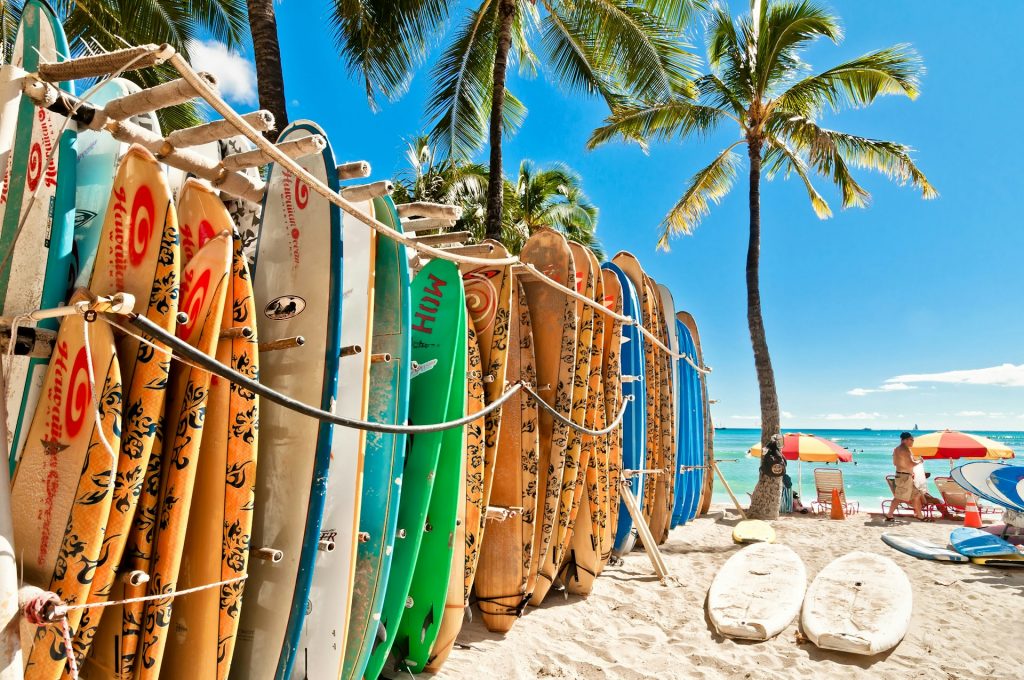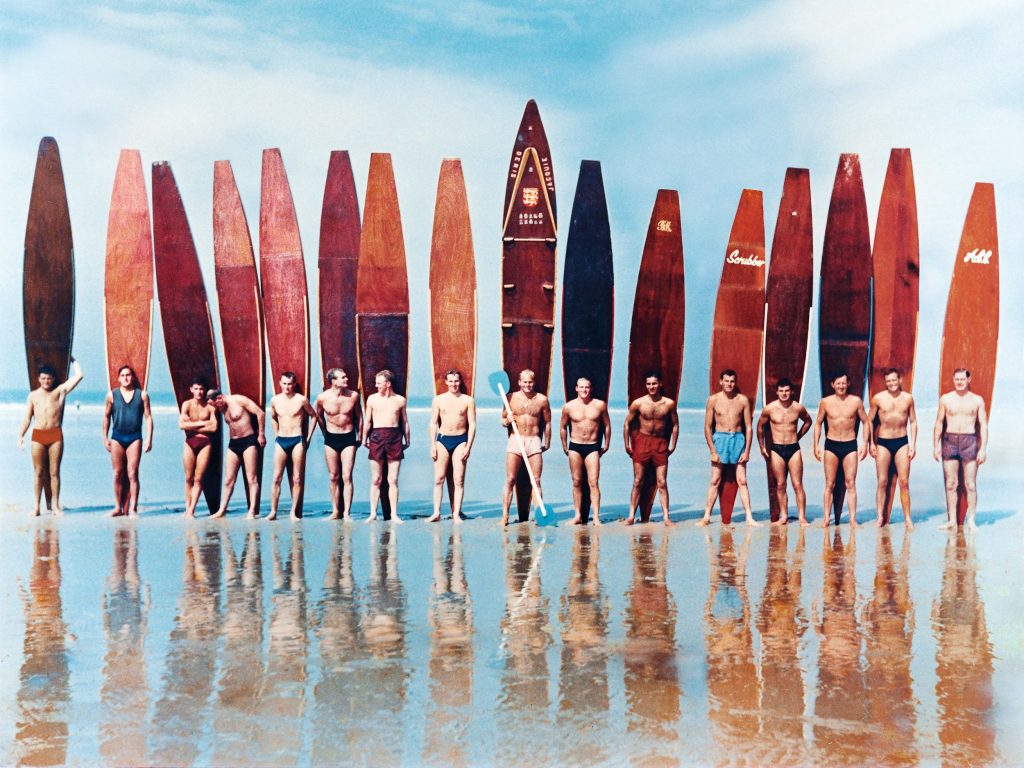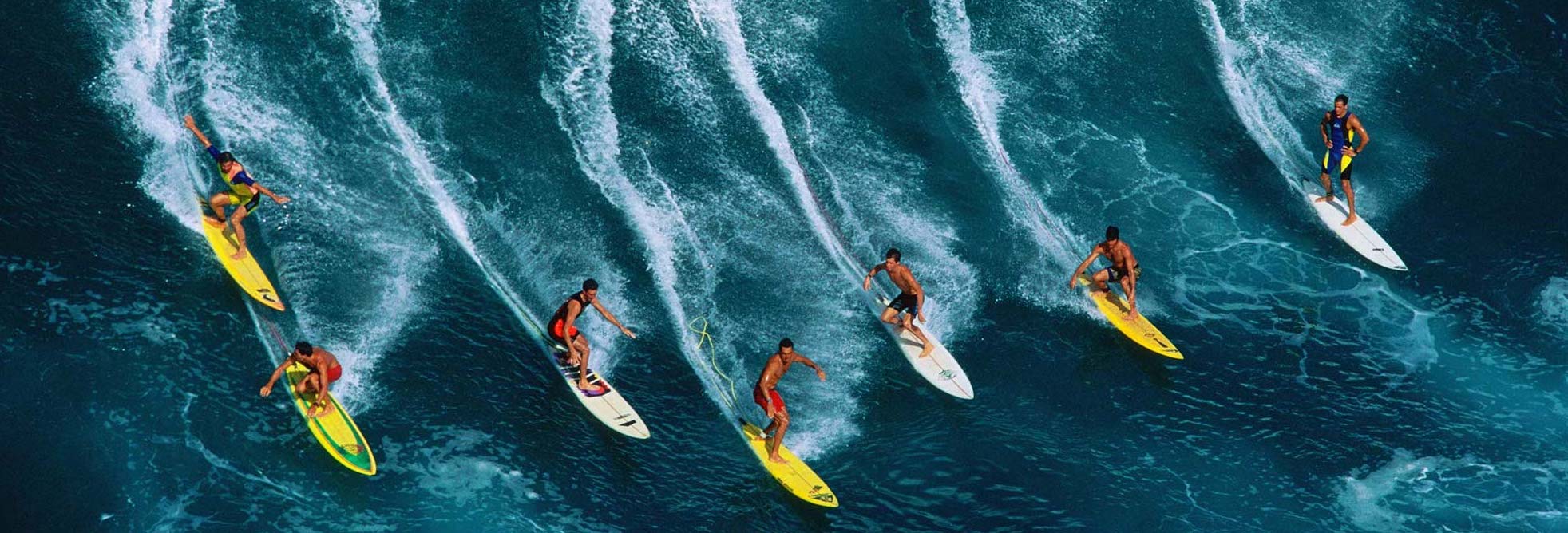History of surfing or a reason for relocation to Hawaii
Surfing is not just a sport, it is an art form that allows a person to connect with nature and feel its power and majesty. At its core, surfing is a unique combination of sportsmanship and cultural heritage that represents freedom, adventure and harmony with the world around us.
The history of surfing dates back to ancient times. Although many people associate surfing solely with the beaches of Hawaii, its origins can be found in various parts of the world where local cultures utilized similar activities for fun and sustenance.

In ancient times, many peoples living on the shores of oceans and seas utilized similar ways of traveling on the water. One of the most famous examples is the Polynesians, who since ancient times have been making voyages on special wooden boards similar to modern surfboards. As the practice spread, it acquired not only the function of a means of transportation, but also the significance of a ritual and cultural event. Surfing became an integral part of their customs and traditions, symbolizing man’s connection to nature and the ocean.
Other parts of the world, including Africa, South America, and the Pacific, also had similar types of water activities, although they may have taken different forms and had their own characteristics.
The importance of surfing to different cultures was immense. It served as a means of communication between generations, passing wisdom and traditions from one generation to the next. Being a good surfer meant being respected and honored in society. In addition, surfing played an important role in the spiritual life of many peoples, associated with religious rituals, holidays and legends.
Thus, surfing has been an important part of the culture of various peoples since ancient times, reflecting their attitude to nature, the sea and life in general. The sport not only combines skills and physical fitness, but is also a powerful cultural symbol that continues to inspire and attract people from all over the world.
Ancient forms of surfing

Surfing has ancient roots and its origins in various parts of the world where the sea and ocean played an important role in peoples’ daily lives. The history of ancient forms of surfing includes unique methods and techniques that have been used by different cultures for fun, transportation, and even in religious rituals.
One of the most famous examples of ancient surfing is the Polynesians living in the islands of the Pacific Ocean. Since ancient times, Polynesians have used long wooden boards called “olo,” “alaia,” or “paipo” to ride the waves. These boards were carved from strong woods and had long, narrow shapes that allowed the surfer to glide easily over the waves. Polynesian surf masters had incredible dexterity and skill, having mastered techniques for controlling the board and balancing on the wave.
Another example of ancient forms of surfing are the Hawaiians, who are considered the pioneers of modern surfing. For the Hawaiians, surfing was not only a way to have fun, but also part of their culture and religion. They used special wooden boards known as “olo”, “alai’a” or “papa he’e nalu” to conquer the waves of the Pacific Ocean. Surfing was closely associated with religious rituals and mystical beliefs, and skill on a board was one measure of strength and prestige in Hawaiian society.
In addition to Polynesians and Hawaiians, surfing was also a popular pastime among other peoples living along the shores of oceans and seas. For example, the peoples of the Marquesas Islands, the Maori of New Zealand, the Chumash Indians of California, and the Aborigines of Australia have also practiced their forms of surfing for centuries.
Ancient forms of surfing were closely tied to the cultural and religious aspects of these peoples’ lives. Surfing was not only a sporting pastime, but was also a symbol of connection with nature, the sea and spiritual forces. These ancient surfing methods and techniques inspired and became the basis for the modern surfing we know today.
The development of surfing in the modern world

Surfing has experienced significant development in the 20th century, evolving from a mere recreational activity into a global sporting and cultural industry. This period is characterized by significant changes in the technology and materials used to make surfboards, as well as the influence of culture and media in popularizing the sport.
Since the middle of the 20th century, there has been a significant shift in surfboard technology. Polyurethane and polystyrene materials began to be used instead of traditional wooden boards, creating lighter, stronger and more controllable boards. These innovations have greatly improved surfers’ abilities and expanded the arsenal of tricks and maneuvers available on the wave.
The influence of culture and media in popularizing surfing on a global scale cannot be overstated. Films, magazines, television shows and, later, the internet have become the main channels for the dissemination and popularization of the sport. Surfing movies such as Endless Summer (1966) and Point Break (1991) became iconic and inspired millions of people around the world.
Surfing’s popularity was also fueled by musical and cultural movements such as the Beach Boys and hippie culture in the 1960s. Many celebrities and musicians such as The Beach Boys, Jan and Dean, and The Surfaris helped strengthen surfing’s associations with beach lifestyle and freedom.
In recent decades, surfing has become not only a sport, but an industry generating billions of dollars. The industry includes the production of surfboards, surf clothing and shoes, and the tourism business associated with surf beaches and resorts.
Technological advances have also affected the education and training of surfers. Modern simulators, virtual simulators and innovative training techniques have helped to improve the skills of novice surfers and develop new training techniques for experienced athletes.
Overall, the development of surfing in the 20th century reflects its transformation from an ancient form of entertainment to a global cultural and sporting industry. Technological innovations and cultural influences have contributed to its global popularity and established its place in the modern world.
Significant moments in the history of surfing

Significant moments in surfing history are closely associated with key events, figures and innovations that have shaped the modern culture and sports industry of this exciting sport.
- Polynesian Roots: The ancient Polynesians are the first known surfers. Surfing was an integral part of their culture and lifestyle, and the first surfboards were made of wood.
- Surfing’s arrival in Hawaii: Surfing came to Hawaii in the 18th century, where it was integrated into the local culture and became part of rituals and festivals.
- The advent of bobber boards: In the early 20th century, Hawaiians George Freeth and Jack Long innovated the shape of boards, giving them greater maneuverability and ease of control on the wave.
- First competitive surfing: In 1928, the first competitive surfing event was held in Hawaii, paving the way for the development of sport surfing.
- Revival of Surfing after World War II: After World War II, surfing became a popular pastime among veterans, which helped it spread in the States.
- Emergence of tournaments and associations: In 1953, the Hawaii Surfing Association was formed in Hawaii, and in 1959, the first World Surfing Championships were held in Peru.
- Cultural influence of movies: In the mid-twentieth century, movies such as Endless Summer (1966) became symbols of surfing and inspired millions of people around the world.
- Professional Surfers: The emergence of professional surfers such as Duke Kahanamoku, Laird Hamilton, and Kelly Slater made surfing more competitive and attractive to young people.
- Industry Growth: Surfing has become a billion-dollar industry that includes board manufacturing, clothing and footwear, travel businesses, and specialty stores.
- Evolution of Technology and Styles: Modern technology and innovation in the form of lightweight and durable board materials, as well as a variety of styles and tricks, have made surfing even more exciting and accessible to all.
These significant moments in surfing history have had a huge impact on the development of the sport and its influence on culture and society. They have not only shaped surfing’s modern image, but also consolidated its place in the world’s sporting and cultural panorama.
Surfing in culture and art

Painting and Photography
Many artists and photographers find inspiration in surfing, depicting the beauty of the ocean, waves, and surfers. The work of artist John Seeliger and the photographs of Bruce Brown reflect the aesthetics and spirit of surfing.
Subcultures
Surf Punk and Beach Culture are social and cultural movements associated with surfing. They reflect the rebelliousness, freedom, and alternative lifestyles that characterize many surfers.
Festivals and Events
Many surf festivals and competitions are held around the world, attracting thousands of surf fans. These events stimulate cultural exchange and promote the surfing community.
All of these aspects demonstrate how surfing is infiltrating different spheres of culture and art, leaving its mark in music, film, literature and visual art.
The Future of Surfing

Surfing continues to evolve and its future represents a combination of innovation, environmental responsibility and social change.
- Technological innovation: Modern technology is bringing innovation to the world of surfing. This includes the development of lighter and stronger surfing materials, innovative forms of board design, and the use of virtual reality to simulate waves.
- Evolution of styles: Surfing styles are constantly changing due to new tricks, fashions and trends. Surfers today are experimenting with different styles such as freestyle, tube-riding, longboarding and wakeboard surfing.
- New places to practice: Advances in technology and the availability of information allow surfers to discover new places to practice. This includes remote beaches, previously unexplored bodies of water and even artificial waves created specifically for surfing.
- Environmental eesponsibility: Surfing is becoming increasingly environmentally conscious. Surfers are actively involved in beach cleanup projects, fighting ocean pollution and protecting marine life, bringing attention to environmental issues.
- Social relevance: Surfing builds community and culture by bringing people of different ages, nationalities and social statuses together. Surf festivals, camps and competitions encourage social interaction and the development of friendly relationships.
- Competitions and events: Surfing is becoming an increasingly popular sport and recreational activity, which is reflected in the increasing number of competitions and events around the world. This includes world championships, national tournaments, and charity and social events.
Overall, the future of surfing is a combination of technological innovation, respect for nature, social interaction and community development. The sport will continue to attract new fans and remain an important part of culture and lifestyle around the world.
We realize that for many surfers, moving can be challenging. Our company is ready to provide professional moving services so you can focus on your new adventure. We can help you move your equipment, boards, and personal belongings to where the ocean and waves await you. Trust us with your move so you can freely and confidently immerse yourself in the world of surfing, creating your own story of excitement and joy.
Contact us in any way:
Telephone: (954) 773-9667
E-mail: abs@absoluteinc.org





